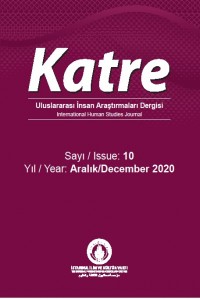Combination of Scientific and Religious Worldviews in the Works of Christian and Muslim Thinkers of the 20th Century
Öz
The crisis of the positivist worldview in the twentieth century has caused attempts of combining scientific and religious paradigms. A number of authors from different religious backgrounds tried to put together scientific approaches on the technical level, and religious values on the spiritual level. The call for a combination of science and religion was an important feature of Western Christianity during the twentieth century, appearing even in pope`s encyclicals. Despite the secular Western worldview is rooted in Christianity, it withdrew far enough to see it as religiously neutral. Thus, Christian and Muslim thinkers, and Said Nursi among them, tried to renew a connection between religious values and scientific knowledge where the religion is responsible for grounding an ontological and epistemological context, and the science is a part of practical implementation of the worldview based on religion.
Anahtar Kelimeler
Kaynakça
- Berlin, I. 1999. “The Purpose of Philosophy” In Concepts and Categories: Philosophical essays, 1-11. London: Pimlico.
- Embong, R. 2017. “Integrated Education as a Solution for Educational Dualism from Said Nursi’s Perspective”. PEOPLE: International Journal of Social Sciences Volume 3 Issue 2: 914-928.
- Habermas, J. 2006. “Secularization as a twofold and complementary learning process” In Ratzinger, J., and Habermas, J. Dialectics of Secularization: On Reason and Religion, 43-47. San Francisco: Ignatius Press.
- Kepel, Gilles. 1994. The revenge of God: the resurgence of Islam, Christianity, and Judaism in the modern world. University Park: Pennsylvania State University Press.
- Markham, Ian and Suendam Birinci Pirim. 2011. An Introduction to Said Nursi: Life, Thought and Writings. Farnham: Ashgate Publishing Limited.
- Teilhard de Chardin, P. 2002. “Christ the Evolver” In Christianity and Evolution, 138-150. Orlando: Harvest.
- Vahide, Sukran. 2019. Bediuzzaman Said Nursi: Author of the Risale-i Nur. Kuala Lumpur: Islamic Book Trust.
- Barbour, I. 2000. Religion and Science. Historical and Contemporary Issues. Moscow: BBI.
- Gaidenko, P. 1997. “Christianity and Genesis of Modern EuropeanNatural Sciences” In Philosophical-Religious Issues of the Science, 44-87. Moscow: Martis.
- Markova, L. 1999. “Theology in the postmodern era”. Philosophy questions № 2: 109-127.
- Eckartshausen, K. 1993. Key to the Mysteries of Nature. Tashkent: Shark.
Combination of Scientific and Religious Worldviews in the Works of Christian and Muslim Thinkers of the 20th Century
Öz
20. yüzyıldaki pozitivist dünya görüşünden ortaya çıkan bunalım bilimsel ve dini paradigmaların birleştirilmesi teşebbüslerine yol açtı. Farklı dini altyapısı olan birçok müellif teknik düzeyde bilimsel yaklaşımlar ve manevi düzeyde de dinî değerler oluşturmaya çalıştılar. Bilim ve dini birleştirme çağrısı 20. Yüzyıl Batı Hristiyanlığının önemli bir özelliği olarak ve hatta Papa’nın genelgelerinde yer aldı. Seküler Batı dünya görüşünün kökü Hristiyanlığa dayanmasına rağmen dinî olarak tarafsız görünemeyecek kadar kökeninden uzaklaştı. Böylece aralarında Said Nursi’nin de bulunduğu Hristiyan ve Müslüman ilahiyatçılar bilimsel bilgiye dinî değerler katmaya ve yeni bir evrensel sistem inşa etmeye çalıştılar ki bu düzende bilim yeni teknik icatlardan sorumlu iken dinin mesuliyet alanını da ahlak oluşturuyordu.
Anahtar Kelimeler
Kaynakça
- Berlin, I. 1999. “The Purpose of Philosophy” In Concepts and Categories: Philosophical essays, 1-11. London: Pimlico.
- Embong, R. 2017. “Integrated Education as a Solution for Educational Dualism from Said Nursi’s Perspective”. PEOPLE: International Journal of Social Sciences Volume 3 Issue 2: 914-928.
- Habermas, J. 2006. “Secularization as a twofold and complementary learning process” In Ratzinger, J., and Habermas, J. Dialectics of Secularization: On Reason and Religion, 43-47. San Francisco: Ignatius Press.
- Kepel, Gilles. 1994. The revenge of God: the resurgence of Islam, Christianity, and Judaism in the modern world. University Park: Pennsylvania State University Press.
- Markham, Ian and Suendam Birinci Pirim. 2011. An Introduction to Said Nursi: Life, Thought and Writings. Farnham: Ashgate Publishing Limited.
- Teilhard de Chardin, P. 2002. “Christ the Evolver” In Christianity and Evolution, 138-150. Orlando: Harvest.
- Vahide, Sukran. 2019. Bediuzzaman Said Nursi: Author of the Risale-i Nur. Kuala Lumpur: Islamic Book Trust.
- Barbour, I. 2000. Religion and Science. Historical and Contemporary Issues. Moscow: BBI.
- Gaidenko, P. 1997. “Christianity and Genesis of Modern EuropeanNatural Sciences” In Philosophical-Religious Issues of the Science, 44-87. Moscow: Martis.
- Markova, L. 1999. “Theology in the postmodern era”. Philosophy questions № 2: 109-127.
- Eckartshausen, K. 1993. Key to the Mysteries of Nature. Tashkent: Shark.
Ayrıntılar
| Birincil Dil | İngilizce |
|---|---|
| Konular | Din Araştırmaları |
| Bölüm | Hakemli Makaleler |
| Yazarlar | |
| Yayımlanma Tarihi | 31 Aralık 2020 |
| Gönderilme Tarihi | 8 Nisan 2020 |
| Kabul Tarihi | 28 Aralık 2020 |
| Yayımlandığı Sayı | Yıl 2020 Sayı: 10 |
Katre Uluslararası İnsan Araştırmaları Dergisi Creative Commons Atıf-Gayri Ticari 4.0 Uluslararası Lisansı ile lisanslanmıştır.
https://dergipark.org.tr/tr/pub/katre
E-mail: katre@iikv.org



